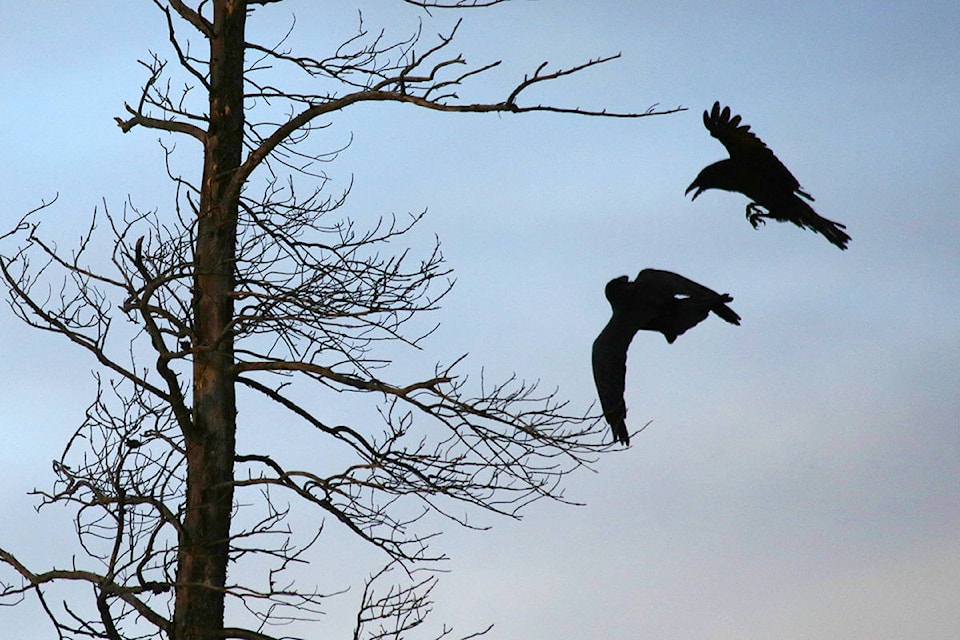There is no doubt that ravens — those most cunning, audacious and outspoken of birds — hold a place of honour in the Yukon. The raven is the territorial bird, ubiquitous in the North, and the symbol of one of the five clans of the Tlingit. Every Yukoner has a raven story: a particular game a certain pair of birds play, a clever trick performed at the perfect moment, an unsettlingly watchful individual bird.
This reputation for intelligence and charm is well deserved, says Environment Yukon conservation biologist Cameron Eckert. They are, he says, “the smartest of birds with a complex social structure.”
“Both recent and First Nations cultures have a reverence for ravens in the North.”
Ravens are unusually astute problem solvers, capable of taking cues from humans, he says. For example, if there is a bird’s nest — a possible food source for ravens, who love the eggs of other bird species, as any chicken farmer will tell you — and a person stops to look up at it, a raven is capable of noting this interest and will come back when the person is gone to check it out, Eckert says.
“(The) raven is a bird that outwardly enjoys life. They play together a lot … in the updrafts, clasping talons, duking it out in the air … which seems to have no other (biological) purpose than fun.”
The raven mating season starts in mid-winter, in January and February, and during this time people may observe pairs flying together, clasping talons, riding updrafts and doing acrobatics together. This behaviour, he says, serves the practical purpose of scouting out potential nest sites and the social purpose of creating and strengthening the relationship between mates, which is called “pair-bonding.” While they don’t necessarily mate for life, ravens do mate “for the long term” and practice a sort of avian serial monogamy, Eckert says. Usually this means a pair will stay together until one of them dies or they have a failed mating season and do not successfully rear young, at which point they may “switch it up.”
Ravens like to nest in sheltered high-up places, such as cliff faces, bridges and water towers. They build their nests out of mud and sticks (or, if available, they will just reuse an old one) sometime in February and then settle into domestic bliss (and, presumably, some sweet bird lovin’).
Like many other birds, ravens are capable of adjusting the number of eggs they lay based on the resources available in a given season. In a good year, this can be as high as six, although in leaner years it can drop to only three or four, says Eckert.
“This output is based on an assessment of the resources available at hand,” says Eckert. “It takes a female raven a lot of energy investment to lay an egg.”
Once the eggs are laid, ravens incubate them at the same time in an attempt to try to synchronize when they hatch so that one isn’t substantially bigger or more developed than the others, which would allow it to hog up resources. Hatching starts in April, and there is usually one egg which hatches later or is smaller than the others, despite the best effort of the parents, says Eckert, a sort of “runt of the litter” nestling. This little one usually doesn’t survive into adulthood, with the overall survival rate of the raven chicks dependant on the of their parents to find food.
The chicks are out of the nest by June, which is fairly early in the season, biologically speaking, Eckert notes. This early fledging time gives baby ravens the opportunity to learn from their parents longer, so they can be better equipped to find food for themselves in the long — and rapidly approaching — upcoming winter.
Ravens are complicated social animals with complex hierarchies, Eckert says. This allows them to work together in ways many birds do not, such as performing a “bait and switch” with dogs, wolves and other predators, where in one bird distracts the target, allowing the other to grab a piece of meat or garbage and then fly safely away. Working in a group like this is beneficial for individual birds, even when resources are limited, as they are in winter, he says.
“You have to share whatever food you find with other ravens,” he says. “But you also have other ravens to help you find food when you can’t.”
Ravens — as anyone who has ever accidentally left the lid of their trashcan over night or their dog food open on the porch can attest to — are opportunist feeders and scavengers. The Whitehorse dump “has a significant positive impact on the raven population,” Eckert notes.
“They will basically take advantage of whatever is available to them,” Eckert says.
While it’s impossible to know the precise number of ravens that live in the Yukon, he says, the annual Christmas bird count (which, for ravens, is tabulated at the aforementioned dump) can give a general idea. There are thousands of pairs, he says, and at least 5,000 individuals, although that number may actually be much higher.
“Ravens come and go with the seasons,” he says. “And you see them most often (in Whitehorse) in the winter and fall, especially in the Porter Creek area.”
These birds congregate in the forest in Porter Creek during the depths of winter to conserve body heat at night, forming roots which can number as many as 1,500 birds, he says.
“There’s hundreds of them in the forest at night,” he says. “It’s quite spectacular.”
Contact Lori Fox at lori.fox@yukon-news.com
